Enjoy DatePsychology? Consider subscribing at Patreon to support the project.
Glancing through articles on dating app deal-breakers, I noticed two limitations:
- Poll items of deal-breakers are often selected by the pollsters. While we can all come up with lists of what deal-breakers are to us individually, we’re likely to miss what others consider deal-breakers.
- The extent to which an item is a deal-breaker is often not well quantified. There may be high disagreement in what constitutes a deal-breaker. Further, some deal-breakers may be controversial. They may even be a plus for some individuals while being a deal-breaker for others.
Below is my data on dating app deal-breakers. I also assessed dating app use, openness to casual sex, a desire for monogamy, male height, and recent sexual behavior.
I find the results here to be quite consistent with past research on dating apps, current sexual behavior statistics, and some well-replicated sex differences in evolutionary psychology. I assess the current results in the discussion section in the context of past research.
I also discuss the results in the context of what I call “promiscuity narratives:” popular, but mostly incorrect, beliefs in our folk psychology that promiscuity is very common. The current data, as well as past research on dating apps, may challenge some of what you believe about dating app use and sexual behavior.
Methodology
I collected 130 responses from Twitter describing dating app deal-breakers and coded them into survey items for men and women. Next I collected a social media convenience sample (N = 438; 130 female). The mean age for men was 33(SD 10) and for women was 32(SD 8). 89% of survey participants were heterosexual, 10% were bisexual, and 1% were gay or lesbian.
A single 5 point Likert scale item was used to assess openness to casual sex and a desire for monogamy.
Binary variables were coded for past and current dating app use, committed relationship status, sex within the past twelve months, and sex within the past three years.
Height was self-reported and converted to centimeters.
In assessing deal-breakers, participants were asked to imagine a dating profile where the photo presented was someone who is physically attractive enough for them to swipe right on (or accept). The idea being that participants should assess deal-breakers in the context of a physically attractive photo.
Deal-breakers were rated on a Likert scale of 1-5. A 1 indicated that they would be highly willing to compromise, or to overlook the deal-breaker. A 5 indicated an absolute deal breaker they would always swipe left on (or reject the profile of), regardless of how attractive the person in the photo was.
Results
Deal-breaker scores
Below are tables presenting the deal-breaker scores for men and women. The left column is a percentage of the maximum score. The right column is the percentage of total scores that rated the item a 5, or the percentage of participants who would absolutely reject a dating profile with that item.
Here I present the deal-breakers without comment. In the discussion section I will give an analysis and tie these in with past research.
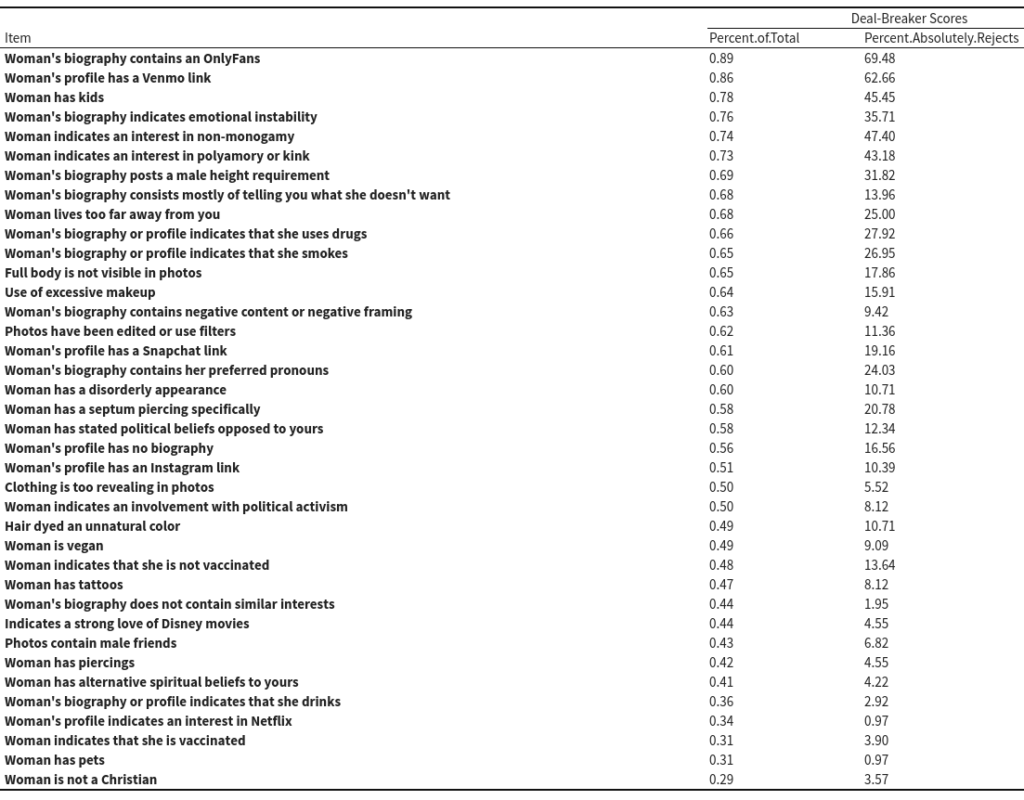
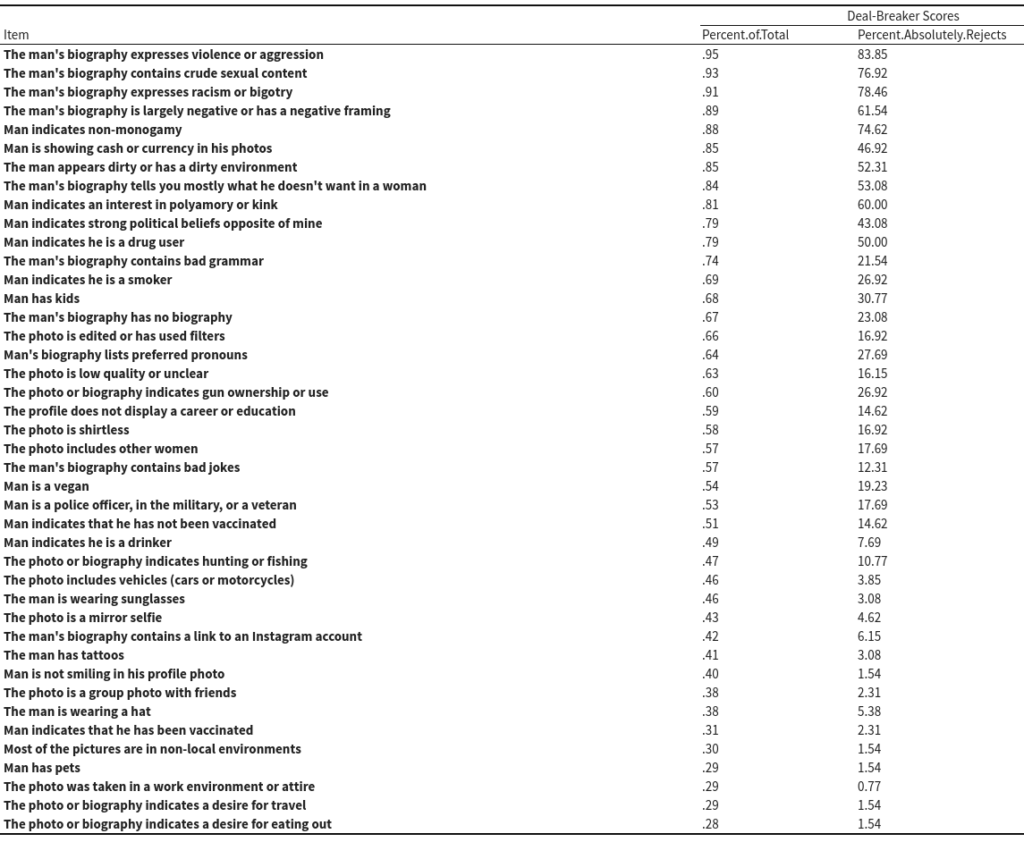
Sex differences in a desire for monogamy and openness to casual sex
Across the full sample, sex differences emerged for a desire for a monogamous relationship and for openness to casual sex.
The mean score for men was 2.99 (SD 1.39) and for women was 1.94 (SD 1.23). The results showed a statistically significant difference between the groups, t(307.62) = 8.86, p < .001, CI [0.82, 1.92], with a large effect size (Cohen’s d = 0.84, 95% CI [0.63, 1.05]).
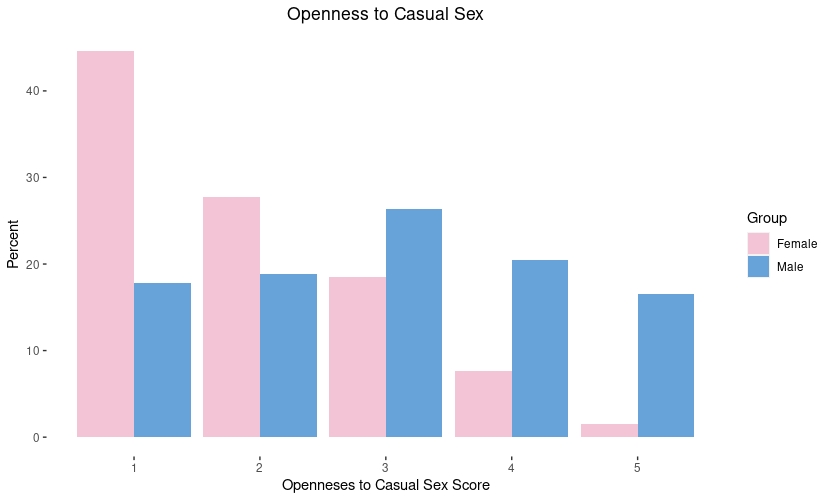
The mean score on desire for a monogamous relationship for men was 4.14 (SD 1.17) and for women was 4.49 (SD 1.21). This was a statistically significant difference(t(289.72) = -3.59, p = .0004, CI [-0.55, -0.16]), but the size of the effect was small (Cohen’s d = -0.35, 95% CI [-0.55, -0.14]).
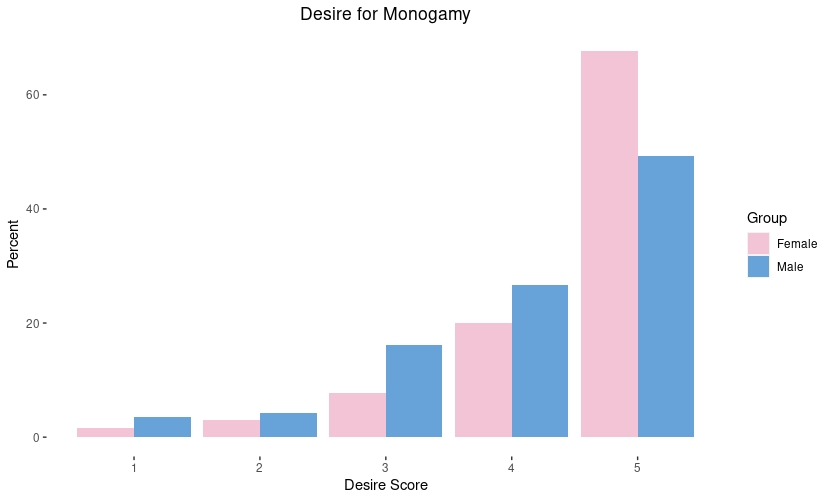
Past vs current dating app use
A Pearson’s chi-squared test with Yates’ correction was conducted to examine the relationship between sex and past dating app use. This revealed a non-significant association, X²(1, N = 438) = 2.4275, p = 0.1192. Most men and women had used a dating app at some point in the past: 83.61% of men and 76.92% of women.
However, there were significant sex differences in current app use (X²(1, N = 438) = 8.3056, p = 0.004). Of men, 41.67% were current dating app users, while of women 26.15% were current app users.
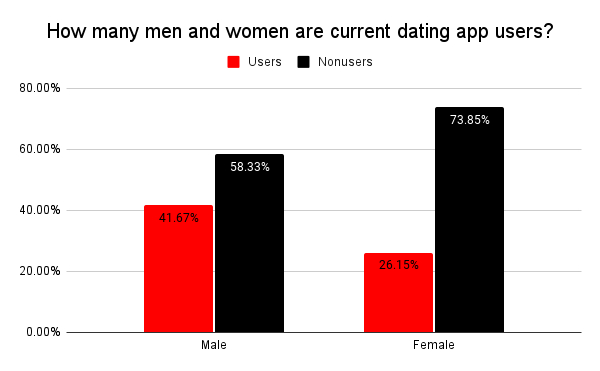
The effect of male height
I found a significant, but small, effect of male height (S = 6380890, rho = -0.31, p < .001) on one deal-breaker item. Men who were taller were slightly less likely to assess a female requirement for male height as a deal-breaker.
However, taller men were not more likely to have higher standards, or lower deal-breaker scores (r(306) = -0.04, p = 0.455, 95% CI [-0.1537, 0.0694]). Tall men were not more likely to judge a woman listing her preferred pronouns in her biography as a deal-breaker (S = 4906987, rho = -0.0077, p = 0.8933).
Male height also did not predict a lower desire for monogamous relationships (W = 3131, p = 0.3512), nor a greater openness to casual sex (W = 6824, p = .4369).
Tall men were not more likely to be in a committed relationship (t(180.58) = 0.9425, p = 0.3472, CI[-0.88, 2.49), nor more likely to have had sex within the past three years (t(128.28) = -0.1297, p = 0.897, CI[-2.07, 1.8).
Tall men were also not more likely to be current dating app users (t(290.39) = -0.1534, p = 0.8782, 95% CI[-1.7, 1.46]).
Male height binned
Splitting the data into tall and short might not be the best way to compare it. For example, Frederick (2015) found no difference in lifetime sexual partners between average men and between tall men, but did find a small difference in sexual partners between short and tall men. I performed a second analysis after splitting my male data into three categories: short, medium, and tall.
First, here is a histogram of my male height data:
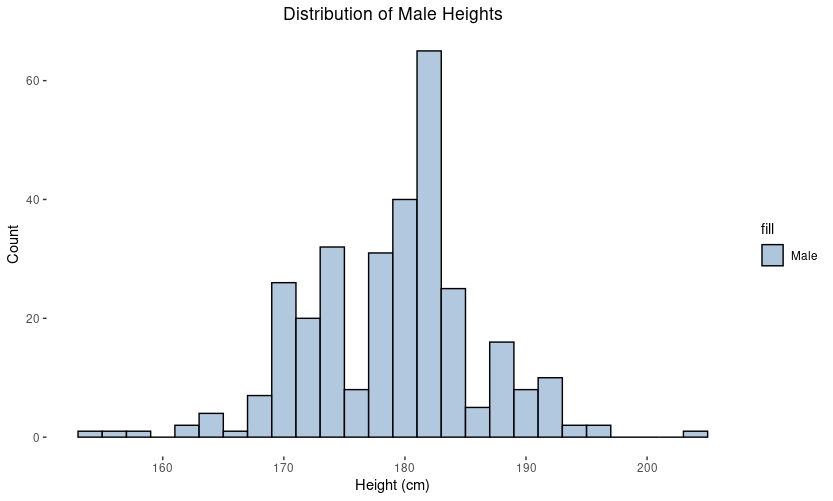
What stands out? Well, most men reported being around 183cm, or 6’. My sample was not random and representative, so it could be the case that respondents really were that height. More likely, however, is that a lot of men just guestimate 6’ or round to it. This will determine how I split my data: arbitrary researcher’s choice, I binned all men shorter than 175cm (5.74’) into the “small” category, between 174 and 185 (6.06’) into the “medium” category, and men 185 and up into the “large” category.
I reran a chi-square test for committed relationship status for my three groups. Again, I didn’t find a statistically significant difference (χ²(2, N = 308) = 4.64, p = 0.10). Of men in the small group, 26.32% were in committed relationships, 33.73% in the medium group, and 18.18% in the large group.
For sex in the past three years, I did find a statistically significant relationship (χ²(2, N = 308]) = 9.78, p = 0.01). However, the men who were least likely to be without sex in the past three years were not the shortest men. 63.16% of men in the small category, 79.88% of men in the medium category, and 65.9% of men in the large category had sex within the past three years.
The relationship between male height and sex within the past twelve months was also not significant (χ²(2, N = 308]) = 9.78, p = 0.052). Again, a higher proportion of men in the medium category reported sex within the past twelve months (68%), followed by the large category (56.82%) and the small category (53.68%).
Again, chi-square test for current dating app use: not statistically significant (χ²(2, N = 308]) = 0.59579, p = 0.7424). The percentages of current app users for small, medium, and large categories were 39%, 43%, and 39% respectively.
An ANOVA for my three height groups didn’t reveal a significant difference for openness to casual sex (F(2, 305) = 1.3171, p = 0.2694) and did not reveal a significant difference for a desire for monogamy (F(2, 305) = 1.6624, p = 0.1914).
Dating app use and sexual behavior
Being in a committed relationship emerged as the best predictor of being sexually active. 93.33% of men and 92.86% of women in committed relationships reported having had sex within the past twelve months. In contrast, 49.08% of men and 51.35% of women not in a committed relationship reported having had sex within the past year. The difference between men and women was not statistically significant (χ²(2, N = 438]) = 1.769, p = 0.1835).
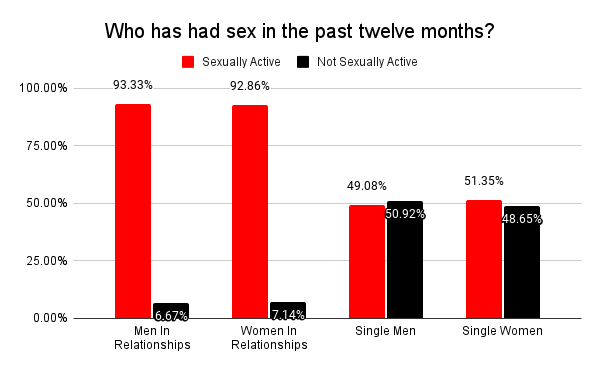
Single men and women on dating apps were more likely to have had sex within the past twelve months. However, there was no significant sex difference (χ²(2, N = 149]) = 0.003, p = 0.9549). Of current dating app users, 65.22% of men and 67.65% of women had sex within the past 12 months.
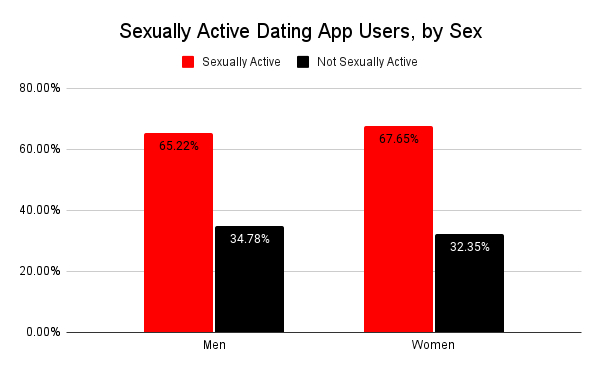
Men who used dating apps and had sex within the past twelve months were not more sexually selective (they did not have higher deal-breaker scores) than men on apps who did not have sex (t(84.99) = -0.9154, p = 0.3625, CI[-10.93,4.04]). Male dating app users who were sexually active were also not more selective than male non-users who were sexually active (t(186.5) = -1.5952, p = 0.1124, CI[ -11.41,1.21]).
However, men who were on dating apps and who were sexually active were less selective than men who both did not use dating apps and who were not sexually active (t(156.99) = -3.8964, p < 0.001, CI[-20.23,-6.62]). This effect was moderate (Cohen’s d = -0.61).

No significant differences emerged for women who were sexually active on dating apps (t(13.62) = -0.2566, p = 0.8013, CI[-21.69,17.06]), on dating apps but not sexually active (t(45.92) = -0.2893, p = 0.7736, CI[-9.83,7.36]), nor abstinent from both sex and app use (t(42.9) = -1.0782, p = 0.287, CI[-13.44,4.07]).
A one-way ANOVA was conducted to examine the relationship between casual sex openness and deal-breaker sensitivity. The effect of casual sex openness was significant (F(4, 433) = 14.55, p < .001). The size of the effect was moderate. Casual sex openness explained approximately 12% of the variance (ηp² = .118).
A Tukey post hoc test with Bonferroni correction was performed to compare the levels. Participants who reported the highest level of casual sex openness had significantly higher rejection scores than those who reported lower levels of casual sex openness (ps < .001), while participants who reported level 4 had significantly higher rejection scores than those who reported levels 1-3 (ps < .05). No significant differences were found between levels 2 and 3 (p = .156) or between levels 3 and 4 (p = .890).

Further, this effect is driven primarily by men. Splitting by sex, the ANOVA remains significant for men (F(4,303) = 8.833, p < .001), but not for women (F(4,125) = 0.644, p = .632).
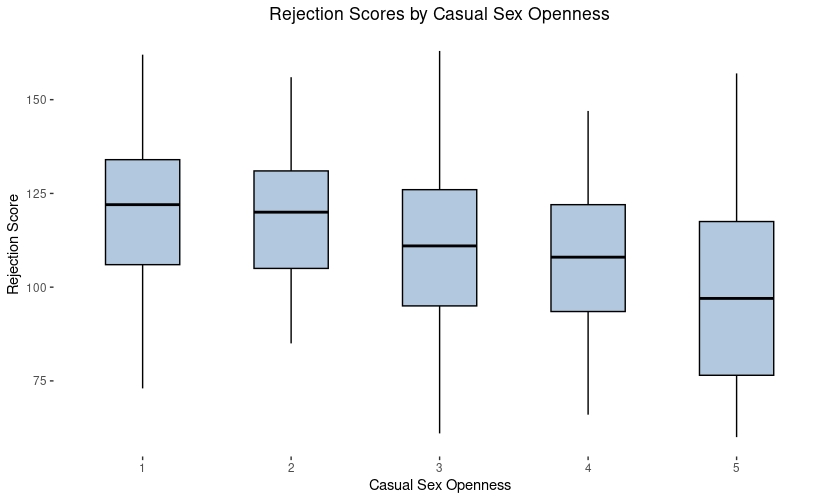
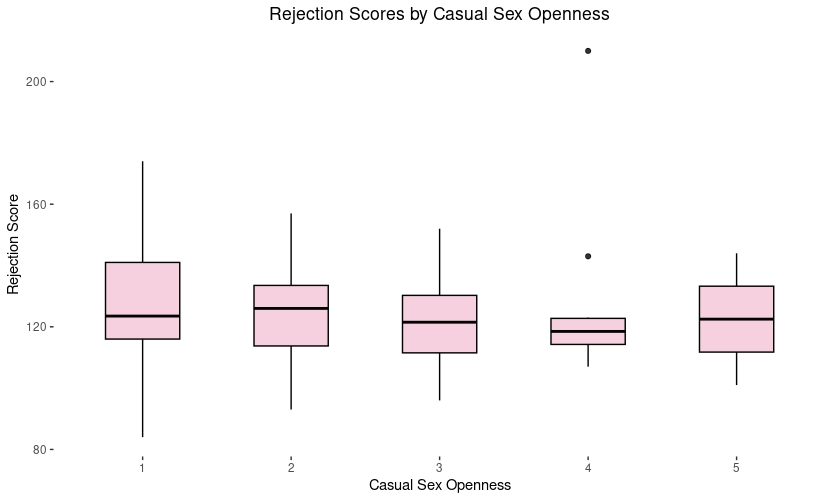
Consistent with this, women who were current dating app users were not less selective than women who were not current app users (t(53.552) = -0.38375, p = 0.7027, CI[-9.5136, 6.4572]). Male dating app users, however, were slightly less selective than men not currently using dating apps (t(288.38) = -3.0193, p = 0.0028, CI[-12.4842, -2.6309], Cohen’s d = -.34).
Age, app use, desire for monogamy, and openness to casual sex
An ordinal logistic regression indicated that age was not a significant predictor of openness to casual sex for women (β = 0.0007, SE = 0.0189, t(0.03543), p > .05). However, the relationship was significant for men (β = -0.03422, SE = 0.0189, t(-3.182), p < .05). As age increased, men were more open to casual sex.
A desire for monogamy was also not associated with age in women (β = -0.03422, SE = 0.0189, t(-4.1973), p > .05), but was for men (β = -0.03422, SE = 0.0189, t(-4.1973), p < .05). Although not significant for women, the direction of the association was similar to that in men: a desire for monogamy decreased with age.
To test this further, I split men and women by age 25 into young and old age groups and performed a nonparametric Wilcoxon test. The difference in openness to casual sex and a desire for monogamy was not different for old and young male, nor old and young female, comparisons.
I then split men and women by age 30. Again, the differences between young and old groups for both men and women were not statistically significant.
Split by age 25, a slightly higher proportion of young women were current app users (30.77% vs 25%). However, this difference was not statistically significant (χ²(2, N = 130) = 0.122, p = 0.7269). 41% of both the young and old male groups were current dating app users.
Discussion
Sex differences in a desire for monogamy and openness to casual sex
The sex difference in openness to casual sex in my data (d = .84) closely mirrors past research on sex differences in sociosexuality. In a large multinational study across 53 nations, Lippa (2009) found a sex difference in sociosexuality at .74. Penke (2011) reported a SOI Desire effect size of .84, while Simpson and Gangestad’s (1991) original research on sociosexuality found an effect size of .73. This is perhaps unsurprising; a sex difference in sociosexuality is both one of the largest and most well-replicated effects observed in evolutionary psychology.
This is also one way that men regularly misunderstand women and is related to what I call “promiscuity narratives.” It’s especially evident in discourse on dating apps. Men may incorrectly believe that because women receive many more matches on apps that women are also more sexually promiscuous, given that they have more opportunity to be. It’s quite understandable how one would arrive at that belief, but it is wrong.
Consistent with the data here and past data, women are not only less open to casual sex, but much more selective than men. That women are more selective for mates, both in long and short term contexts, is again one of the more well-replicated findings in evolutionary psychology (Buss, 1998; Schmitt et al., 2001). Men may think “this is how I would behave if I were a woman who got lots of matches on Tinder,” without taking into account the personality differences between men and women that shape sexual behavior.
Men in my data also indicated a high desire for monogamy (the mean score was a 4.14 for men and 4.49 for women, out of a possible 5). This again is consistent with past research in evolutionary psychology, which indicates that both men and women prioritize long term relationships. We evolved to pair bond — which does not imply exclusive lifelong monogamy nor an absence of infidelity — and pair bonding is the dominant mating pattern across human cultures (Schacht & Kramer, 2019). It is not contradictory that men are both open to casual sex and have a high desire for monogamous relationships. As Buss and Schmitt (2019) have noted, the pursuit of a “dual mating strategy” may be more common in men than in women. Men may benefit more from pairing long term partnership with infidelity (or casual sex) than women do from an evolutionary perspective. This is also reflected in the higher rates of infidelity among men (Wang, 2018).
These results also mirror past research on Tinder and a desire for relationships versus openness to casual sex. Botnen (2018) found that men and women active on Tinder reported a similar desire for a long term relationship, but that men were much more open to casual sex than women.
Sex differences in dating app use
There were no sex differences in past dating app use. This is unsurprising, as most men and women may have downloaded an app at some point to try it. More important was the sex difference for current dating app users. 41.67% of current app users were men, but only 26.15% of women were current app users. This is a sex ratio of 1.59 to 1.
Existing data on dating app sex ratios is spotty. I have seen estimates that range from a 50% difference to a difference as high as eight times as many men. We don’t have much in the way of official app data, most likely because dating apps have a strong financial incentive not to reveal a highly skewed sex ratio (particularly given that it is almost exclusively men who use the paid features of apps). Nonetheless, what data does exist consistently shows that men outnumber women on apps. The current data here is consistent with that and may even be a low estimate, given that my participants were a social media convenience sample (we are all people who are very online, so we may also be more likely to use apps than the general population).
This is always important to keep in mind in the dating app discourse. It is often ignored, despite its importance. First, while most people experiment with apps at some point, most women are not on apps at any given moment. A highly skewed sex ratio means that there is not a woman for every man on apps.
The effect of male height
In past research, male height has been associated with relationship outcomes. For example, taller men are more likely to be married (Sohn, 2015). In a very large sample of men and women (N = 60,058), Frederick (2015) found that tall men did not have more lifetime sexual partners than men of average height, but both did have more sexual partners than short men. Further, the effect of height on lifetime sexual partner count was quite small (β = .05).
This may be counterintuitive, because height does nonetheless emerge as a trait that women consider to be consistently attractive. However, people may regularly overestimate the effect of physical attractiveness on sexual partner count. In my own meta-analysis of research on physical attractiveness and sexual partners, I found a small Cohen’s d of .14.
The reason for this is likely that tall men form monogamous relationships similar to average and shorter men, thus restricting sexual partner count. Most men don’t go without sex for extended periods of time, only about 1% of men remain virgins past age 25 per the most recent General Social Survey data, so it isn’t surprising that I didn’t find a difference in sexlessness over a three year period based on height.
Further, tall men didn’t indicate a higher use of dating apps, nor a higher openness to casual sex. Tall men didn’t indicate lower sexual standards, either, which is associated both in past research and in my data with a higher lifetime sexual partner count.
There is a popular perception that “Chads,” or attractive men, are more promiscuous. Again, this is probably based on the same assumption made about women: that they are because they have the potential to be. What seems consistent in the research however, although perhaps counterintuitive, is that physical appearance predicts promiscuity weakly if at all. Behavior predicts promiscuity much better. Although we do see correlations between some behaviors and physical appearance, they are usually small as well.
What taller men did care less about was a female requirement for a male height. Again, this makes sense. If a man sees in a woman’s profile that he is below the required height she demands, he may be more likely to swipe left. A height requirement affects tall men less, so they may care less. Nonetheless, this was a deal-breaker for many men regardless of height. For a woman trying to optimize her dating profile, avoiding a height requirement could be helpful. This goes along with “laundry list” profiles of “what I don’t like.” Men and women both viewed these negatively and they should be avoided.
Dating app use and sexual behavior
Again, contrary to the “promiscuity narratives” common within our folk psychology, the most sexually active participants were those in committed relationships. Further, men and women not in committed relationships were sexually active at the same rate. This is quite consistent with recent nationally representative data, which indicates rates of annual sexlessness that are similar for women and women.
There was no sex difference in annual sexual activity for men and women who use dating apps. Again, this may be surprising to some. As I wrote in the discussion on sex differences in openness to casual sex, men may assume that because women receive more matches on apps that they are also more sexually active. Past research on dating apps has found, however, that most men and women use them to seek long-term relationships (rather than casual sex), and that we see a sex difference where women use apps for casual sex at rates lower than men (Hobbs et al., 2017; Timmermans & De Caluwé, 2017).
In a probability sample from the United Kingdom, 17% of men and 10% of women reported using online dating apps to seek casual sex partners (Cabecinha et al., 2017). Choi et al. (2016) found a similar rate of casual sex in app users: 18% of men and 11% of women. Grøntvedt et al. (2020) found that only 20% of Tinder users reported ever having casual sex and that, even when matches were plentiful, very few resulted in real-life meet-ups. Further, Grøntvedt et al. found that meet-ups rates for men and women were similar.
The obsession with match rates (which is all we have from Tinder or OKCupid app use data, as it does not track meet-ups or sexual behavior) in dating app discourse may be misleading if you try to infer from it who is having casual sex. In other words, the so-called “80/20 rule” might apply to matches, but not to meet-ups or hook-ups. What would be more accurate is a “15/15” rule, where about 15% of men and women are having casual sex with one another.
In my data, male dating app users who were sexually active were not less selective than those who were not sexually active. In other words, being “too picky” may not be a good explanation for why some men fail to find sex partners on dating apps. This is consistent with recent research on involuntarily sexless men (Costello et al., 2023), which found that they do not have higher mate standards than a control population.
However, in my data men who were both not sexually active and not current dating app users had higher sensitivity to deal-breakers. Past research has found that high sociosexuality and low disgust sensitivity predict using Tinder to seek casual sex (Sevi et al., 2018). Higher sensitivity to deal-breakers might be one pathway through which men both remain sexually abstinent and choose to abstain from dating app use.
Openness to casual sex also predicted lower sensitivity to deal-breakers. This effect was driven primarily by men and was not significant for women. This is consistent with past research in evolutionary psychology that has found women have high standards even for short-term pairings (Buss & Schmitt, 2019). Rather than casual sex reflecting a truly separate mating strategy, it may reflect a stepping stone into a long term partnership. As such, women may share the same deal-breakers for casual partners as for long-term mates. (See also: the shift in evolutionary psychology away from the dual-mating hypothesis).
Age, app use, desire for monogamy, and openness to casual sex
Part of our folk psychology “promiscuity narratives” is that women go through a “wild phase” while young and “settle down” with age. However, recent research has found that young men and women are abstaining from sex at unprecedented rates. This is part of a broader trend of extended adolescence (see the second part of this article for research). My data is consistent with this: age was not associated with openness to casual sex nor a desire for monogamy in women. For men, age was inversely associated in a logistic regression. The youngest men were the most desirous of monogamy and the least open to casual sex.
When I split men and women by age, both at age 25 and age 30, I didn’t find a difference in a desire for monogamy nor openness to casual sex. Young women and young men were also not more likely to be current app users.
Deal-breakers, so what?
Men and women have different deal-breakers, but across similar items women were more sensitive to deal-breakers than men were. An exception was dating a single mother or a single father. For men, 45.45% of men indicated that they would absolutely reject a woman with children. This was the third highest item for men, behind having an OnlyFans or Venmo in the biography. In contrast, 30.77% of women indicated that they would absolutely reject a single father. On the list for women, this was number fourteen.
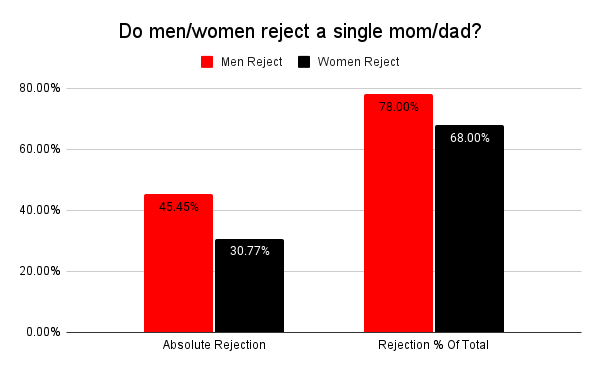
This is a result you could interpret within the context of Sexual Strategies Theory (Buss & Schmitt, 2021). There are a number of reasons why men may be more sensitive to cues of extra-pair paternity. For men, this may represent a higher demand on resources, it may be related to higher sexual jealousy in men (Buss et al., 1992; Sagarin et al., 2012), and it may be an indicator of potential intrasexual male competition (threat from male competitors, or the previous father).
Non-monogamy was more of a deal-breaker for women than it was for men. 47.4% of men said they would absolutely reject a female profile that indicated an interest in non-monogamy, while 74.62% of women said they would absolutely reject it. This was the fifth highest item for women. This likely reflects sex differences in a desire for monogamy and openness to casual sex in the current data and past research. Men may be much more open to casual sex when it is on the table. A good example of this is the classic research of Clark and Hatfield (1989). When an attractive woman approached a male stranger and proposed sex, most accepted on the spot. When an attractive man approached a female stranger, all women rejected the proposal of casual sex.
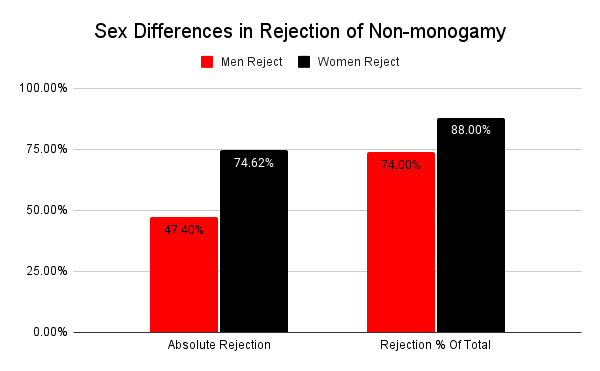
In my data, a few items I have seen listed as deal-breakers in popular media also did not emerge as deal-breakers for most women. For example, only 16.92% of women reported that they would absolutely reject a male profile with a shirtless photo. Only 5.38% reported that they would reject a man wearing a hat — despite the reported phenomenon of “hatfishing,” or using a hat to cover baldness. Similarly, only 3% reported that they would reject a profile of a man wearing sunglasses and 1.54% reported they would reject a profile if the man was not smiling.
Polarizing themes that reflect politics or ideology emerged as strong deal-breakers for a substantial minority of women. 43% of women indicated they would reject a profile indicating opposing political beliefs, 27.69% indicated they would reject a profile that listed preferred pronouns, and 17.69% indicated they would reject a profile from a law enforcement, military member, or veteran. 26.92% indicated they would reject a profile that indicated or displayed firearm ownership, while 10.77% indicated they would reject a man whose hobbies were hunting or fishing. 19.23% would reject a man who is a vegan.
Not having a biography was also less of a deal-breaker than you might expect: 23.08% of women said they would absolutely reject a profile with no biography.
The most agreed upon reasons for absolute rejection by women were any display of violence or aggression, crude sexual commentary, and racism or bigotry. No men indicated a similar item in their deal-breakers. Again, safety and the risk of physical harm go hand-in-hand with mate selection from the evolutionary perspective (Barrett et al., 2002). Women are highly attuned to cues of threats. Men may represent threats to their person and offspring. Evolutionary psychology aside, a great deal of violence toward women is also domestic in the modern environment. Although men also experience domestic violence, it is notable that men did not have similar fear-based deal-breakers.
Posting “what I don’t want,” or “laundry lists” in biographies also scored highly as a deal-breaker for women, but less for men. I’m surprised it wasn’t higher. Starting off your first interaction by telling a partner what you don’t want is a negative framing and unlikely to help you much. Similarly, men rated a “male height requirement” high on their list of rejection items, even if they were themselves tall.
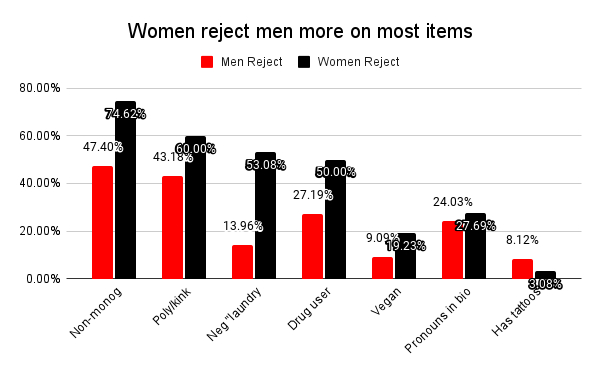
Men were more compromising on opposing political beliefs, but rejected preferred pronouns in a biography as highly as women did (24%). Men also disliked septum piercings (20%).
All of these items represent the maximum score possible, or the participants who said they would absolutely reject it. As such, they likely underestimate the negative effect of most deal-breakers, which is better captured in the percentage of the maximum score.
References
Barrett, L., Dunbar, R., & Lycett, J. (2002). Human evolutionary psychology. Princeton University Press.
Botnen, E. O., Bendixen, M., Grøntvedt, T. V., & Kennair, L. E. O. (2018). Individual differences in sociosexuality predict picture-based mobile dating app use. Personality and Individual Differences, 131, 67-73.
Buss, D. M., Larsen, R. J., Westen, D., & Semmelroth, J. (1992). Sex differences in jealousy: Evolution, physiology, and psychology. Psychological science, 3(4), 251-256.
Buss, D. M. (1998). Sexual strategies theory: Historical origins and current status. Journal of Sex Research, 35(1), 19-31.
Buss, D. M., & Schmitt, D. P. (2019). Mate preferences and their behavioral manifestations. Annual review of psychology, 70, 77-110.
Buss, D. M., & Schmitt, D. P. (2021). Sexual strategies theory. In Encyclopedia of evolutionary psychological science (pp. 7509-7513). Cham: Springer International Publishing.
Cabecinha, M., Mercer, C. H., Gravningen, K., Aicken, C., Jones, K. G., Tanton, C., … & Field, N. (2017). Finding sexual partners online: prevalence and associations with sexual behaviour, STI diagnoses and other sexual health outcomes in the British population. Sexually Transmitted Infections, 93(8), 572-582.
Choi, E. P., Wong, J. Y., Lo, H. H., Wong, W., Chio, J. H., & Fong, D. Y. (2016). The association between smartphone dating applications and college students’ casual sex encounters and condom use. Sexual & reproductive healthcare, 9, 38-41.
Clark, R. D., & Hatfield, E. (1989). Gender differences in receptivity to sexual offers. Journal of Psychology & Human Sexuality, 2(1), 39-55.
Costello, W., Rolon, V., Thomas, A. G., & Schmitt, D. P. (2023). The Mating Psychology of Incels (involuntary Celibates): Misfortunes, Misperceptions and Misrepresentations.
Frederick, D. A., & Jenkins, B. N. (2015). Height and body mass on the mating market: Associations with number of sex partners and extra-pair sex among heterosexual men and women aged 18–65. Evolutionary Psychology, 13(3), 1474704915604563.
Hobbs, M., Owen, S., and Gerber, L. (2017). Liquid love? dating apps, sex, relationships and the digital transformation of intimacy. J. Sociol. 53, 271–284.
Lippa, R. A. (2009). Sex differences in sex drive, sociosexuality, and height across 53 nations: Testing evolutionary and social structural theories. Archives of sexual behavior, 38, 631-651.
Penke, L. (2011). Revised sociosexual orientation inventory. Handbook of sexuality-related measures, 622, 625.
Sagarin, B. J., Martin, A. L., Coutinho, S. A., Edlund, J. E., Patel, L., Skowronski, J. J., & Zengel, B. (2012). Sex differences in jealousy: A meta-analytic examination. Evolution and Human Behavior, 33(6), 595-614.
Schacht, R., & Kramer, K. L. (2019). Are we monogamous? A review of the evolution of pair-bonding in humans and its contemporary variation cross-culturally. Frontiers in Ecology and Evolution, 230.
Schmitt, D. P., Shackelford, T. K., & Buss, D. M. (2001). Are men really more’oriented’toward short-term mating than women? A critical review of theory and research. Psychology, Evolution & Gender, 3(3), 211-239.
Simpson, J. A., & Gangestad, S. W. (1991). Individual differences in sociosexuality: evidence for convergent and discriminant validity. Journal of personality and social psychology, 60(6), 870.
Sevi, B., Aral, T., & Eskenazi, T. (2018). Exploring the hook-up app: Low sexual disgust and high sociosexuality predict motivation to use Tinder for casual sex. Personality and Individual Differences, 133, 17-20.
Sohn, K. (2015). The value of male height in the marriage market. Economics & Human Biology, 18, 110-124.
Timmermans, E., and De Caluwé, E. (2017). To tinder or not to Tinder, that’s the question: an individual differences perspective to Tinder use and motives. Pers. Indiv. Differ. 110, 74–79.
Wang (2018). Who Cheats More? The Demographics of Infidelity in America. Institute for Family Studies.
8 comments
Typo under dating app use and sexual behavior, should say men and women instead of women and women, I assume.
Otherwise, thank you for this. I enjoyed the read.
I have a septum and a face tattoo and tend to attract men who were deeply invested in these aesthetic choices
However, I think they tend to be a bit more cautious about what friends and family could or do think about them. I think despite saying certain things about the individual dating preferences, people aren’t always dating as individuals and being partners with someone can imply/signal attraction/acceptance/not-disgust to others in ways one may not prepared to share or share in every context.
One should be wary of saying people are this or that when relying mainly on declarative data 😉